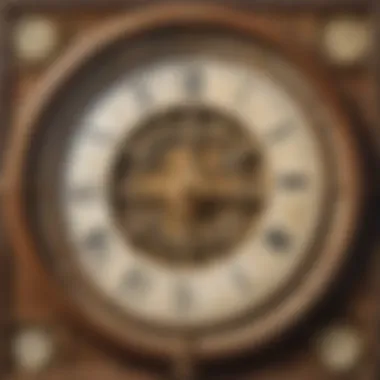Unraveling the Complexity of Analog Clocks: A Deep Dive


Creative Activities
Analog clocks, with their intricate design and historical significance, serve as a fascinating subject for creative exploration. Dive into the world of analog timekeeping through hands-on craft ideas that children can easily replicate. From creating paper plate clocks to designing their own miniature timepieces, these engaging activities not only enhance children's motor skills but also deepen their appreciation for the mechanics of time measurement.
Fun Quizzes
Engage young learners in the realm of analog clocks with captivating quizzes centered around timekeeping concepts. Test their knowledge on topics such as the parts of an analog clock, Roman numeral comprehension, and time-telling accuracy. Through a variety of question types including multiple-choice, fill-in-the-blank, and matching exercises, these quizzes aim to reinforce children's understanding of analog clocks while making learning enjoyable and interactive.
Fact-Based Articles
Embark on a journey of discovery with fact-based articles exploring the diverse facets of analog clocks. From their historical evolution to their role in modern timekeeping, these articles present information in a captivating and easy-to-understand manner suitable for elementary school children, parents, and caregivers. Delve into additional resources provided to expand your knowledge on analog clocks and deepen your understanding of this timeless invention.
Introduction to Analog Clocks
Analog clocks are not merely time-telling devices; they represent a blend of history, mechanics, and artistry. In this comprehensive guide to analog clocks, we will unravel the intricate details that make these timepieces unique. From understanding the fundamental concepts to appreciating their historical significance, this section will serve as a foundational piece in your journey of grasping the essence of analog clocks.
Definition and Basic Concept
Analog vs. Digital: Key Differences
When comparing analog and digital timepieces, the key distinction lies in their representation of time. Analog clocks feature traditional clock faces with moving hands to indicate hours, minutes, and sometimes seconds. On the other hand, digital clocks display time numerically using digits. The choice between analog and digital often comes down to personal preference and situational context. Analog clocks have a classic appeal and are favored by those seeking a traditional touch in timekeeping. Meanwhile, digital clocks offer precise time readings with minimal room for misinterpretation.
Clock Face and Hands
The face of an analog clock serves as a canvas where time unfolds. The arrangement of numbers, markings, and hands plays a crucial role in conveying time accurately. The clock hands, including the hour, minute, and second hands, move rhythmically to mark the passage of time. Each hand has a specific length and design to help differentiate between time units. While the clock face provides a visual reference for time, the hands bring movement and life to the concept of timekeeping.
Historical Background


Origins of Analog Clocks
The origins of analog clocks can be traced back to ancient sundials and water clocks. These early timekeeping devices paved the way for the development of mechanical clocks that used gears and weights to measure time. The transition from sundials to mechanical clocks marked a significant advancement in timekeeping precision and reliability. Analog clocks, with their intricate gears and escapements, represent a legacy of innovation in the field of horology.
Influence on Timekeeping Systems
Throughout history, analog clocks have played a pivotal role in shaping timekeeping systems. From regulating daily routines to synchronizing public events, analog clocks have been instrumental in harmonizing human activities with the consistent flow of time. The transition from analog to digital timekeeping reflects a shift towards modernity and efficiency, yet the innate charm and symbolism of analog clocks continue to resonate in our contemporary world.
Components of an Analog Clock
In this intricate exploration of analog clocks, understanding the components is paramount. The hour hand, minute hand, and second hand collectively form the essential elements of an analog clock. These components not only delineate time but also showcase the meticulous craftsmanship and engineering that underpin these timekeeping devices. The hour hand, indicating the hour on the clock face, plays a foundational role in time-telling, setting the pace for the day. In contrast, the minute hand, with its more granular movements, provides a finer resolution for time measurement. Meanwhile, the second hand, often denoting the seconds, adds a level of precision and sophistication to analog clocks. Emphasizing these components sheds light on the intricate workings of analog clocks and establishes their significance in daily life.
Hour Hand
Role and Functionality
The hour hand of an analog clock serves as a primary indicator of the hour within a given time period. Its robust presence on the clock face offers a quick reference point for discerning the current hour, enabling users to track time effortlessly. The distinctive feature of the hour hand lies in its deliberate design to be shorter and thicker compared to the minute and second hands. This strategic variation allows for easy differentiation between the time units displayed on the clock, enhancing readability and user engagement. While the hour hand may seem subtle in its movements, its pivotal function in conveying the primary hour cannot be understated. Its presence is fundamental to the overall coherence of analog clocks, emphasizing the importance of precise hour measurements.
Design Variations
Diving deeper into the nuances of analog clock design reveals a myriad of hour hand variations that cater to diverse aesthetic preferences and functional requirements. From traditional arrow-shaped hour hands to contemporary geometric designs, the hour hand lends itself to creative interpretations while retaining its fundamental timekeeping role. Some analog clocks feature ornate hour hands with intricate patterns or decorative elements, adding a touch of elegance to the timepiece. On the other hand, minimalist designs opt for sleek and understated hour hands that prioritize functionality over embellishment. These design variations not only reflect the artistic sensibilities of clockmakers but also underscore the adaptability of analog clocks to different stylistic preferences.
Minute Hand
Precision and Measurement
When it comes to precise time-tracking, the minute hand on an analog clock plays a crucial role in delineating each minute within the hour. Its elongated design and incremental movements facilitate accurate time readings, allowing users to discern subtle changes in the passage of time. The minute hand's meticulous measurement intervals ensure that time is segmented effectively, aiding in time management and scheduling tasks efficiently. The minute hand's precision is exemplified by its seamless coordination with the hour hand, culminating in a synchronized display of time that is both functional and visually engaging.


Movement Mechanics
The movement mechanics of the minute hand dictate its smooth transitions across the clock face, regulating its rotational speed and trajectory. Engineered with precision gears and mechanisms, the minute hand glides along its designated path with calculated efficiency, offering a seamless timekeeping experience. Whether driven by traditional mechanical mechanisms or modern quartz technology, the movement of the minute hand underscores the intricate craftsmanship embedded within analog clocks. By understanding the intricate movement mechanics of the minute hand, users can appreciate the technical ingenuity that enables accurate time measurement and synchronization.
Second Hand
Fine Timekeeping
For those seeking utmost precision in time measurement, the second hand on an analog clock provides a refined level of accuracy and detail. Operating at a smaller scale than the hour and minute hands, the second hand marks each passing second with meticulous precision, catering to activities that demand exact timekeeping. The continuous movement of the second hand in a fluid manner offers a continuous temporal reference point, highlighting the dynamic nature of time as it unfolds second by second. This fine timekeeping feature not only appeals to users with a penchant for accuracy but also showcases the technical sophistication embedded in analog clock mechanisms.
Technological Advancements
In the realm of analog clocks, technological advancements have revolutionized the functionality and performance of the second hand. Incorporating innovations such as anti-backlash systems and high-torque movements, modern analog clocks boast enhanced second hand capabilities that minimize errors and ensure superior timekeeping accuracy. Additionally, the integration of advanced materials and manufacturing techniques has elevated the durability and longevity of second hands, mitigating wear and tear over extended usage. By embracing these technological advancements, analog clocks continue to evolve, offering users a seamless timekeeping experience that blends tradition with innovation.
Functioning of Analog Clocks
Analog clocks play a pivotal role in time measurement, embodying the essence of traditional timekeeping mechanisms. Understanding the functioning of analog clocks delves into the core principles that govern the movement of the clock hands and their coordination in indicating time. Discerning between mechanical and quartz analog clocks unravels a spectrum of insights into the intricacies of timepieces that have stood the test of time. Exploring the functioning of analog clocks equips enthusiasts with a profound appreciation for the meticulous craftsmanship and engineering precision involved in ensuring accurate timekeeping.
Mechanical vs. Quartz
Internal Mechanisms
Delving into the internal mechanisms of analog clocks uncovers the contrasting dynamics between traditional mechanical movements and contemporary quartz precision. The delicate interplay of gears and escapements in mechanical clocks showcases a mechanical marvel that aficionados often cherish. In contrast, quartz clocks harness the oscillations of a quartz crystal to regulate time with unparalleled accuracy. The synergy between these internal mechanisms underscores the evolution of timekeeping technology and the diverse preferences of timepiece connoisseurs.
Accuracy and Maintenance
Precision and maintenance are paramount considerations in discerning the divergence between mechanical and quartz analog clocks. The inherent accuracy of quartz timepieces surpasses mechanical counterparts, offering a hassle-free and consistent timekeeping experience. However, the allure of maintaining the intricate gears and components of mechanical clocks exudes a charm that resonates with traditional horology enthusiasts. Navigating the terrain of accuracy and maintenance provides a nuanced understanding of the trade-offs between convenience and craftsmanship in the realm of analog timepieces.


Timekeeping Principles
Cyclical Nature of Analog Clocks
The cyclical nature of analog clocks encapsulates the perpetual rhythm inherent in time measurement. Analog clocks embody a timeless elegance in their cyclical motion, symbolizing the continuum of time that transcends modern technological advancements. Understanding the cyclical nature of analog clocks fosters a deep connection to the essence of time itself, harmonizing visuospatial perception with temporal awareness.
Adjusting for Daylight Saving Time
Adapting analog clocks for daylight saving time underscores the adaptability and versatility of these timepieces in synchronizing with external temporal shifts. The meticulous adjustment required to align analog clocks with daylight saving time exemplifies the intricate interplay between tradition and modernity in timekeeping practices. The deliberation involved in adjusting analog clocks for daylight saving time cultivates a sense of temporal astuteness and an appreciation for the precision embedded in these classical timepieces.
Significance of Analog Clocks
Analog clocks hold a significant place in the realm of time measurement and understanding the concept of time for various reasons. Firstly, they serve as fundamental educational tools, aiding in teaching time concepts to individuals of all ages. The visual representation of hours, minutes, and seconds through the movement of hands on the clock face simplifies the abstract notion of time into a tangible and comprehensible format. Furthermore, analog clocks play a crucial role in enhancing cognitive skills, especially in children, by fostering the ability to read and interpret time efficiently. This cognitive exercise sharpens mental acuity and time management capabilities, essential for building a structured routine.
Educational Value
Teaching Time Concepts
The Teaching Time Concepts aspect of analog clocks serves as a vital educational tool, offering a hands-on approach to grasp the fundamentals of time measurement. By visually demonstrating the passing of time through the movement of the clock hands, individuals can learn to associate specific hours and minutes with daily activities and scheduling. This interactive method enhances time awareness and organizational skills, crucial for effective time management. Despite the digital era, analog clocks remain a popular choice for teaching time concepts due to their simplicity and direct correlation with everyday timekeeping.
Enhancing Cognitive Skills
The enhancing Cognitive Skills feature of analog clocks contributes significantly to mental development by stimulating cognitive functions related to time perception and interpretation. The act of reading analog clocks involves visual analysis, pattern recognition, and mental calculation, all of which exercise the brain and improve cognitive flexibility. This enhanced cognitive ability translates into better problem-solving skills, spatial reasoning, and overall brain function. While analog clocks may seem traditional, their timeless design continues to play a pivotal role in sharpening cognitive skills and mental agility.
Aesthetic Appeal
Artistic Designs
Artistic Designs in analog clocks bring forth a captivating blend of functionality and visual artistry, elevating them beyond mere timekeeping devices. The intricate details on clock faces, stylish hands, and unique designs reflect the creativity and craftsmanship of clockmakers throughout history. These artistic elements not only enhance the visual appeal of analog clocks but also add a touch of elegance and personality to interior spaces. The Artistic Designs of analog clocks cater to diverse aesthetic preferences, ranging from classic to modern, making them versatile decor pieces suitable for any setting.
Decorative Purposes
Analog clocks serve Decorative Purposes beyond their timekeeping function, serving as eye-catching focal points in any room. Whether adorned with vintage charm or contemporary flair, analog clocks blend seamlessly with various decor styles, adding a touch of sophistication and character. The Decorative Purposes of analog clocks extend beyond mere adornment, as they subtly imbue living spaces with a sense of timelessness and refinement. Integrating analog clocks into home decor not only enhances the visual appeal but also infuses spaces with a timeless elegance that transcends fleeting trends.







